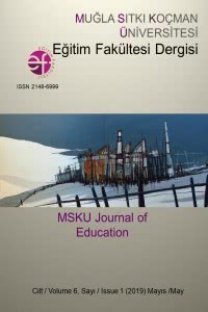İngilizcenin Yabancı Dil Olarak Öğretildiği Ortamda Ortaya Çıkan Kültürlerarası Kimlik
Makale, kültürlerarası kimliğin ortaya çıkması için kişilerin illa kültürlerarası deneyimi yaşamasına gerek olmadığını savunur. Yazar tarafından geliştirilen anket İngilizce öğrenen 19-23 yaşları arasındaki 227 Türk katılımcıya uygulanmıştır. 37 maddelik anketten ve mülakatlardan elde edilen bulgular göstermektedir ki katılımcılarda kısmen farklı bir kimlik oluşmuştur ve İngilizce, sosyalleşme ve kültürlerarası iletişimde yeni deneyimlere kapı aralayan bir servet ve pasaporttur. Son olarak makale, dili öğrenilen toplumun içinde bulunmadan da kültürlerarası kimlikten söz edilebileceğini belirtir.
Anahtar Kelimeler:
yabancı dil öğrenimi, birinci dil kültürü, ikinci dil kültürü, kültürlerarası kimlik, hayali toplumda vatandaşlık
Emerging Intercultural Identity in the Turkish EFL Context
The paper argues that for individuals to develop intercultural identity, they do not necessarily need to experience intercultural experiences. A questionnaire devised by the author is administered to 227 Turkish learners of English aged 19-23. The findings of self-reported responses to a 37-item questionnaire as well as the qualitative data reveal that learners feel they have a slightly different identity and that English is an asset, a passport to a world of new experiences in socialization and cross-cultural communication. The paper concludes that it is legitimate to speak of intercultural identity in the absence of direct contact with L2 community.
Keywords:
foreign language learning, L1 culture, L2 culture, intercultural identity, membership in imagined community,
___
- Brown, H.D. 1986. Learning a second culture. In J.M. Valdes (Ed.), Culture bound: Bridging the culture gap in language teaching (p. 33-48). Cambridge: Cambridge University Press.
- Canagarajah, A. S. 2006. TESOL at forty: What are the issues? TESOL Quarterly, 40, 9-34.
- Fishman, J.A. 1995. On the limits of ethnolinguistic democracy. In T. Skutnabb-Kangas & R. Philipson (Eds.), Linguistic human rights: Overcoming linguistic discrimination (pp. 49-62). New York: Mouton de Gruyter.
- Gardner, R.C. & Smythe, P.C. 1975. Motivation and second language acquisition. Canadian Modern Language Review, 31, 218-230.
- Giles, H. & Johnson, P. 1987. Ethnolinguistic identity theory: A social psychological approach language maintenance. International Journal of the Sociology of Language, 68, 69-99.
- Hall, S. 1992. The question of cultural identity. In S. Hall, D. Held and T. McGrew (eds.) Modernity and its futures. Cambridge: Polity Press in association with the Open University. 274–316.
- He, A. W. 1995. Co-constructing institutional identities: The case of student counselees. Research on Language and Social Interaction, 28, 213-231.
- Kim, Y.Y. 2008. Intercultural personhood: Globalization and a way of being. International Journal of Intercultural Relations, 32, 359-368.
- Kramsch, C. 1993. Context and culture in language teaching. Oxford: Oxford University Press.
- Kramsch, C. 1997. The privilege of the intercultural speaker. In M.Byram and M. Fleming (Eds.) Language Learning in Intercultural Perspective. Cambridge: Cambridge University Press.
- Lambert, W. E. 1963. Psychological approaches to the study of language. Modern Language Journal, 47, 114-121.
- Norton, B. 1997. Language, identity and the ownership of English. TESOL Quarterly, 31, 409-430.
- Ochs, E. 1993. Constructing social identity: a language socialization perspective. Reearch on Language and Social Interaction, 26, 287–306
- Pavlenko, A. 1998. Second language learning by adults: Testimonies of bilingual writers. Issues in Applied Linguistics, 9, 3-19.
- Pavlenko, A. 2002. Poststructuralist approaches to the study of social factors in L2. In V. Cook (Ed.), Portraits of the L2 User. Clevedon, Multilingual Matters, pp. 277-302.
- Peirce, B. N. 1995. Social identity, investment, and language learning. TESOL Quarterly, 29, 9-31.
- Schechter, S.R. & Bayley, R. 1997. Language socialization practices and cultural identity: Case studies of Mexican-descent families in California and Texas. TESOL Quarterly, 31, 513- 541.
- Schumann, J. H. 1978. The acculturation model for second language acquisition. In R. C. Gingras (Ed.), Second Language Acquisition and Foreign Language Teaching, 27-50, VA: Center for Applied Linguistics.
- Selinker, L. 1972. Interlanguage. International Review of Applied Linguistics, 24, 209-239.
- Tajfel, H. 1974. Social identity and intergroup behavior. Social Science Information, 13, 65-93.
- Tajfel, H. 1981. Human groups and social categories. Cambridge: Cambridge University Press.
- Uchida, Y. & Duff, P. A. 1997. The negotiation of teachers’ sociocultural identities and practices in postsecondary EFL classrooms. TESOL Quarterly, 31, 451-486
- Weinreich P. 2009. ‘Enculturation’, not ‘acculturation’: conceptualizing and assessing processes in migrant communities. International Journal of Intercultural Relations.
- ISSN: 2148-6999
- Yayın Aralığı: Yılda 2 Sayı
- Başlangıç: 2014
- Yayıncı: Muğla Sıtkı Koçman Üniversitesi
Sayıdaki Diğer Makaleler
Eğitim, Afet Eğitimi Ve Afete Dirençli Toplum
İngilizcenin Yabancı Dil Olarak Öğretildiği Ortamda Ortaya Çıkan Kültürlerarası Kimlik
Türkiye ve Kazakistan Öğretmen Adaylarının Dijital Okuryazarlık Düzeylerinin Değerlendirilmesi
Mehmet Arif ÖZERBAŞ, Aliya KURALBAYEVA
Ortaöğretim Öğrencilerinin Atom Kavramını Anlama Seviyelerinin Tespiti
Özgür Ulubey, Kasım Yıldırım, Muhammet Mustafa Alpaslan
Özel Dershanelerin Sosyolojik İşlevselcilik Açısından Değerlendirilmesi
Ortaokul Öğrencilerinin “Öğretmen” Kavramına İlişkin Kullandıkları Metaforlar
Çocuk İhmalini ve İstismarını Önlemede Okul Çalışanlarının Sorumlulukları
